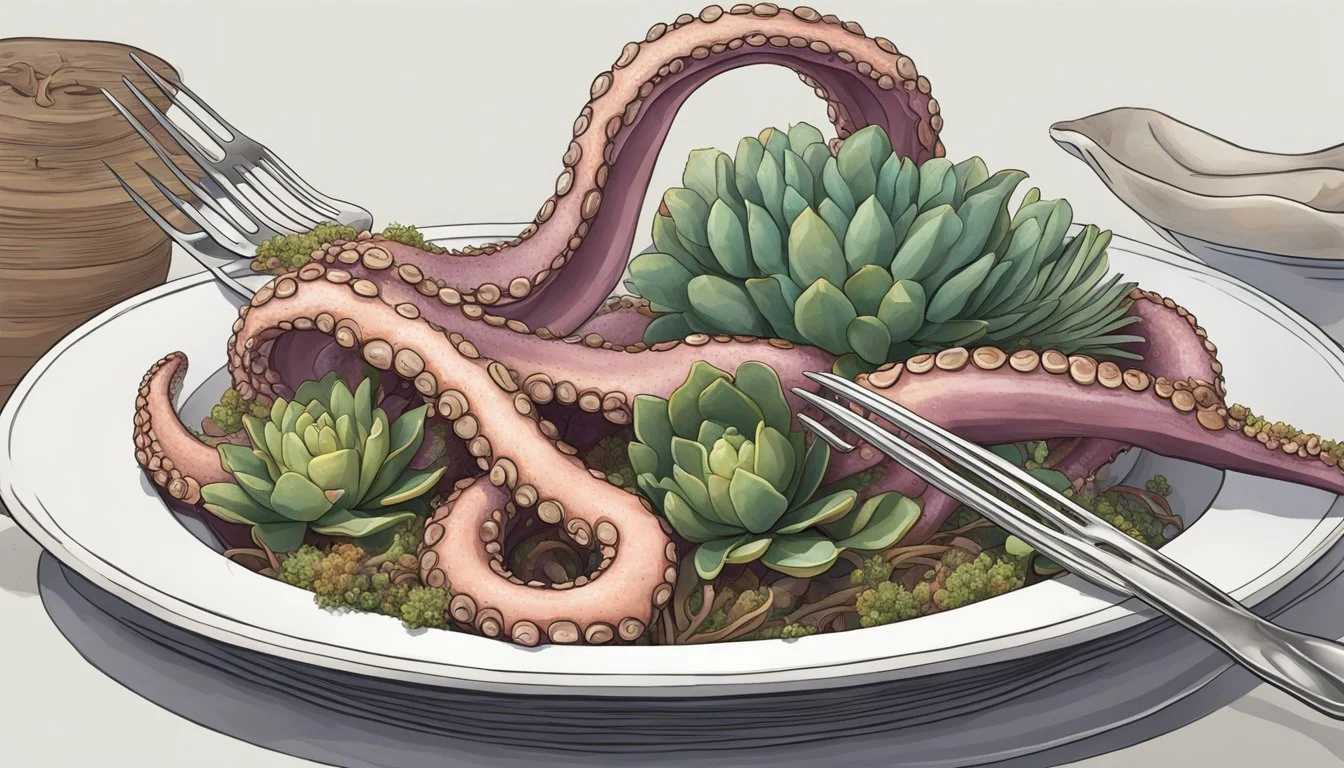How Do You Eat an Octopus?
Culinary Tips for Adventurous Seafood Lovers
Eating octopus is a culinary experience that combines a unique taste with nutritional benefits. This seafood (What wine goes well with seafood?) is considered a delicacy in many parts of the world and is especially popular in Mediterranean and East Asian cuisines. Rich in protein and low in fat, octopus can be a healthy addition to one's diet. Moreover, it offers an array of vitamins and minerals, including iron, zinc, and vitamin B12. When cooked correctly, the texture of octopus can be delightfully tender and a pleasure to savor.
Preparing octopus involves various techniques to achieve the desired tenderness and flavor. Cooking methods such as simmering in a flavorful liquid can help to soften its flesh, making it palatable and enjoyable to eat. The taste of octopus is mild, allowing it to absorb the flavors of accompanying ingredients effectively. This characteristic makes it a versatile component in dishes, pairing well with a range of sauces and seasonings.
The health benefits of consuming octopus extend to heart health, with its notable content of Omega-3 fatty acids contributing to a balanced diet. These fatty acids are essential in maintaining cardiovascular function and reducing the risk of heart disease. By integrating octopus into meals, one not only embarks on a culinary adventure but also embraces a food that supports overall well-being.
Understanding Octopus as Food
Before diving into various ways to appreciate octopus as a culinary delight, it is important to understand its nutritional values, diverse species and habitats, and the range of culinary methods employed around the world.
Nutritional Profile
Octopus stands out as a lean protein source, low in calories and fat, yet high in nutrients. It provides a substantial quantity of essential amino acids, and is low in saturated fat. Per three-ounce serving, octopus offers:
Protein: Approximately 25 grams
Fat: Less than 2 grams
Cholesterol: Roughly 82 milligrams
Omega-3 fatty acids: Contains both eicosapentaenoic acid (EPA) and docosahexaenoic acid (DHA)
Octopus is also rich in minerals such as iron, selenium, calcium, potassium, and phosphorus, and boasts a range of vitamins, including vitamin B12.
Species and Habitat
The term "octopus" refers to a cephalopod living in diverse marine environments, encompassing over 300 species. They inhabit various parts of the ocean, from the shallow tide pools to the abyssal depths. Species such as the giant Pacific octopus can be found in the coastal waters of the North Pacific Ocean, while others are spread out across distinct geographical regions, including the Mediterranean, Korea, and Greece.
Culinary Varieties
As a versatile sea creature, octopus is enjoyed in myriad forms across diverse culinary landscapes. It may be served fresh or delivered as frozen octopus to where octopus dishes are not customary. In Mediterranean cuisine, it's often grilled, while in Korea, it's sometimes eaten raw as a delicacy. Greece is famous for its stewed and grilled octopus, and it's also a staple in sushi (What wine goes well with sushi?) and sashimi in Japanese cuisine. The cooking process generally starts with tenderizing, either through gentle simmering or a massage, and then it can be grilled, marinated, fried, or eaten as is in dishes like takoyaki.
Preparation Basics
Preparing octopus involves meticulous cleaning and specific cooking techniques to enhance flavor and texture. Each step, from initial cleaning to final seasoning, contributes to the overall quality of the dish.
Cleaning and Preparation
First, one must clean the octopus thoroughly, ensuring removal of the beak, ink sac, innards, and eyes. This is usually done with kitchen shears and careful hands. The skin can be left on or removed according to preference, but tenderizing the flesh is crucial. This can include gently massaging with salt or using a meat tenderizer to break down tough muscle fibers.
Remove: Beak, ink sac, innards, and eyes
Tenderize: Massage with salt or use a meat tenderizer
Cooking Techniques
Octopus can be prepared in various ways, including boiling, grilling, simmering, frying, baking, stewing, poaching, or braising. Each cooking method offers a unique texture and flavor to the meat. For instance, a quick boil can soften the meat before it's transferred to a grill or oven, while poaching gently in aromatic liquid contributes to a tender texture.
Softening: Boil before grilling or baking
Tender Texture: Poach in aromatic liquid
Seasoning and Flavor Enhancing
When it comes to seasoning, octopus benefits from olive oil, salt, pepper, garlic, lemon juice, and various herbs and spices. The use of aromatics during the initial cooking octopus phase can infuse the meat with subtle flavors, enhancing the overall dining experience.
Infuse Flavor: Use olive oil, salt, pepper, garlic, and lemon juice
Aromatics: Add herbs and spices during cooking
Cooking Octopus to Perfection
Cooking octopus requires attention to detail to achieve a tender texture without it becoming chewy. It involves methods such as boiling, simmering, and grilling to enhance both texture and flavor.
Achieving Tender Texture
The key to a tender octopus lies in the cooking process which breaks down tough collagen. One starts by boiling the octopus in a pot of simmering water—often with aromatic herbs like bay leaves and vegetable stock. This is usually done for about an hour, depending on the size of the octopus, until the flesh is tender enough to pierce with little resistance.
Grilling and Searing
After boiling, the octopus can be grilled or seared to add a charred texture and smoky flavor. Grilling should be done over high heat for a few minutes per side. It crisps the exterior while keeping the inside succulent. Before grilling, one typically pats the octopus dry, brushes it with olive oil, and seasons with salt for optimal flavor.
Stews and Soups
Octopus also excels in stews (What wine goes well with stews?) and soups (What wine goes well with soups?), where it slowly absorbs the flavors of the surrounding sauce or broth. Stewing entails cooking it at low heat within a flavorful liquid—often containing ingredients like peppercorns, bay leaves, and various vegetables—where it tenderizes over time and enhances the stew's or soup's overall flavor profile.
Health and Safety Considerations
When consuming octopus, individuals should be aware of its nutritional benefits and potential health risks to make informed dietary choices.
Dietary Benefits
Octopus is a seafood that's low in fat and high in protein, offering a range of health benefits. It's an excellent source of several important nutrients, including:
Iron: Vital for healthy blood cells and energy.
Omega-3 fatty acids: Known for reducing inflammation and improving heart health.
Selenium: Plays a role in metabolism and thyroid function.
Vitamin B12: Necessary for nerve function and blood formation.
Additionally, eating octopus can contribute to the intake of minerals like potassium, magnesium, and calcium—essential for maintaining normal blood pressure and bone health.
Potential Risks
As with any seafood, there are certain risks associated with consuming octopus:
Mercury Content: Although lower in mercury compared to some larger fish, it's still important for consumers to be aware of mercury levels and moderate their intake of octopus.
Shellfish (What wine goes well with shellfish?) Allergens: Individuals with shellfish allergies should avoid octopus as it can trigger an allergic reaction.
Proper Cooking: Octopus should be cooked thoroughly to minimize the risk of foodborne illness.
Chewing Hazard: Especially with live octopus, there is a risk of choking due to the suction cups; it's crucial to chew carefully.
Serving and Presentation
When serving octopus, presentation is key, employing vibrant colors and contrasting textures to showcase this seafood delicacy while enhancing its natural flavors through thoughtful accompaniments and pairings.
Accompaniments and Pairings
Serving octopus begins with selecting the right accompaniments to complement its unique flavor and texture. A common approach involves:
Fresh Herbs: Thyme, rosemary, and parsley lend a fragrant note.
Citrus: Lemon juice adds brightness and can cut through the richness of the octopus.
Olive Oil: A drizzle of high-quality olive oil enhances the succulence of the dish.
Vegetables: Sliced onions or a bed of greens provide a crisp counterpoint to the tender seafood.
Cheese: Feta cheese offers a salty, tangy element that pairs well with octopus.
Presentation should leverage the naturally striking color of the octopus against the accompanying elements, creating an enticing and appetizing dish.
Dishing Out
The texture of the octopus is a paramount consideration in its presentation. The following should be noted when plating:
Sushi: Sliced thinly, octopus can be served as sushi, showing off the meat's delicate texture against the simple backdrop of rice.
Sauce: A favorite sauce can be used subtly to accentuate rather than overshadow the flavor of the octopus.
Dressing: A dressing combining olive oil, lemon juice, and selected herbs can be lightly tossed with the octopus before serving.
One must ensure that the octopus remains the star of the dish, with all components serving to elevate the core experience of enjoying this seafood specialty.





